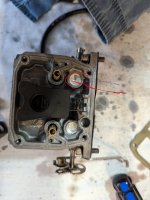I have a 1990 90 hp Johnson. It was idling rough. Compression is 135 each cylinder. After planning off the engine runs fine to 5000. I cleaned both carbs, and replaced a broken vacuum line under the bottom carb to the intake manifold, and all spark plugs. It idled better but still rough. I replaced the power pak, and all coils and plug wires.
Then I unplugged the gray wire to the power pak to disable the fast start spark advance and checked the timing. The timing is supposed to be 28 BTDC. It was about 14 BTDC. I increased the timing and ran the engine. The idle speed is now about 2000 rpm. Carb throttles verified closed. I ran the timing back to 14 BTDC and the idle is down a little. Occasionally the rpm surges.
What is causing the high idle?
The 1990 V4 90HP is a crossflow motor with
no fast start spark advance. The gray wire is the tach signal to the RPM gauge.
Do you have the factory OEM service manual for this engine or not? If you are messing up your timing with too much advance by not knowing how to do it correctly, you could grenade a piston.
From the way it sounds, you do not know the correct procedure for the linkage and synchronization.
Max timing is set either on the water under load, with test wheel in water or via the Joe Reeves method.
Most people prefer the Joe Reeves method if it works with that model of OMC outboard.
A TDC spark plug tool that fits in the spark plug threads. See the factory service manual for how to do this.
Timing gun
12V remote start switch. Read the service manual wiring diagram closely for terminal placement or you'll just create a circuit with no resistance and burn up the remote starter switch or send 12 volts where it doesn't belong and damage something in ignition.
1. Verify TDC mark on flywheel pointer is accurate on #1 cylinder per OEM service manual.
2. Drain gas of outboard for safety reasons, clean up and let dry.
3. Pull spark plugs
4. Ground the plug wires except for #1 cylinder.
4. Get spark gap tester on #1 and close the gap completely to eliminate spark risk
5. Put timing gun reader on #1 spark plug wire.
6. Put water muffs on so you don't run the impeller dry cranking the motor.
7. Turn key to ignition on.
8. Advance throttle to wide open throttle in neutral. If that is not possible on your control box, disconnect the shift cable for safety reasons and shift into forward so you can go WOT.
9. Use remote starter switch to bypass ignition key start for this. Positive terminal goes to battery positive. Negative terminal of this switch goes to the starter
solenoid positive post. This provides +12 volts to starter solenoid to bypass ignition key.
9. Turn motor over with timing gun pointed at flywheel pointer facing the flywheel marks.
Max timing via joe reeves method is -4 degrees of max timing (max 28 degrees BTDC) so it would be no more than 24 degrees BTDC. 22 degrees BTDC would be a safer choice. See the factory service manual for the proper adjustment method to adjust max timing.
With the throttle at the minimal (stop point) for idle, check timing again using Joe Reeves method. Should be around -2 to 0 degrees BTDC. Idle timing and idle RPM is handled by the long screw. See the factory manual for description.
Once that is set correctly. Make sure the carb throttle bodies are closed completely and synced to the throttle arm properly per factory service manual.
Be aware when you finish the link and sync you may have to increase the idle adjustment screw by only a few degrees. The goal is to do as little adjustment as possible at this point, just to get it running.
Once you get it running get it warmed up at medium idle 1250 to 1500 rpm max. Then lower the throttle to where the engine timing to within (+/-1) of -4 degrees BDTC on the timing gun running and verify the carbs are completely closed. The engine should be running around 900 to 1100 RPM at this point.
At that point if the carbs are completely closed and within that -4 degrees BDTC, it should run correctly around 1000 to 1200 RPM out of the water. 850 RPM in the water at idle in neutral, and around 650 RPM on the water under load.
The final adjustment of the idle should be done in the water and under load using the idle adjustment screw. Don't forget to adjust for changes in throttle cable tension on the cable.
This video gives helpful visual clues but it is no substitute for the service manual unless you are a top level technician who knows these extremely well.




















